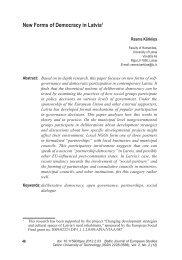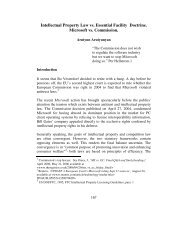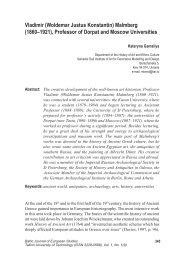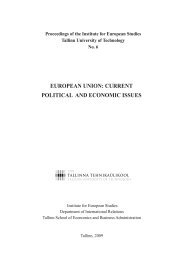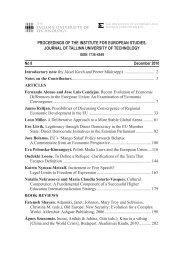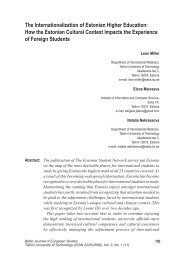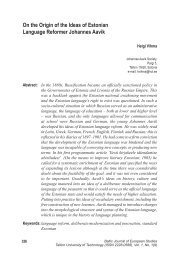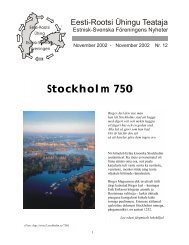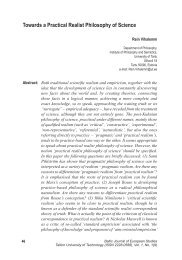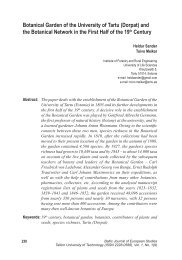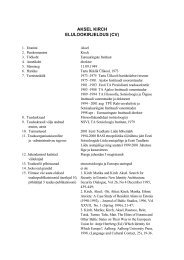Rein Mägi. BALTGRAF - The Institute for European Studies
Rein Mägi. BALTGRAF - The Institute for European Studies
Rein Mägi. BALTGRAF - The Institute for European Studies
Create successful ePaper yourself
Turn your PDF publications into a flip-book with our unique Google optimized e-Paper software.
<strong>Rein</strong> Mägi<br />
SHORT COMMUNICATIONS:<br />
<strong>BALTGRAF</strong>: Engineering Graphics in the Baltic States<br />
<strong>Rein</strong> Mägi<br />
Tallinn University of Technology<br />
Ehitajate tee 5,<br />
Tallinn 19086, Estonia<br />
e-mail: rmagi@hot.ee<br />
On 5 November 1991, after revolutionary political events (the collapse of the<br />
Soviet Union), representatives of engineering graphics departments in the three<br />
Baltic States summoned at the Vilnius Technical University. <strong>The</strong>y declared the<br />
following:<br />
Considering<br />
• the changed political status of our states,<br />
• the necessity to coordinate our ef<strong>for</strong>ts in engineering education,<br />
• the necessity to assure concordance of diplomas (bachelor’s and master’s<br />
degree) of our states,<br />
• we have decided to found the International Association <strong>BALTGRAF</strong> of<br />
engineering graphics departments in Estonia, Latvia and Lithuania.<br />
<strong>The</strong> aims of <strong>BALTGRAF</strong> are<br />
• to coordinate our ef<strong>for</strong>ts in methodical and program equipment of<br />
departments of engineering graphics,<br />
• to coordinate research in our departments in the sphere of engineering and<br />
computer graphics,<br />
• to coordinate our ef<strong>for</strong>ts in adaptation of international standards of technical<br />
drawings,<br />
• to organize international conferences that refer to problems of engineering<br />
graphics departments,<br />
• to consolidate our ef<strong>for</strong>ts in the sphere of named problems with other<br />
universities in the Baltic region.<br />
Professor Petras Audzijonis from the Vilnius Technical University was elected<br />
the first president of <strong>BALTGRAF</strong>.<br />
390<br />
Baltic Journal of <strong>European</strong> <strong>Studies</strong><br />
Tallinn University of Technology (ISSN 2228-0588), Vol. 1, No. 1(9)
SHORT COMMUNICATIONS<br />
Founders of the association decided to regularly (every two years) organize<br />
international conferences on engineering graphics.<br />
<strong>The</strong> first conference of <strong>BALTGRAF</strong> took place in 1992 at the Vilnius Gediminas<br />
Technical University (<strong>BALTGRAF</strong>, 1992). At the conference, 17 papers on<br />
descriptive geometry, technical drawing and computer drawing were presented.<br />
It is pointed out in the introductory note to the volume of the conference<br />
proceedings that the main goal of engineering graphics is graphic literacy – the<br />
ability to create and understand technical drawing. This ability is indispensable<br />
<strong>for</strong> hand-drawing and also <strong>for</strong> computer-drawing. <strong>The</strong> serious problem <strong>for</strong> all<br />
the conference participants was the increasingly tenuous grasp of subjects of<br />
graphics among students at technological universities and secondary schools.<br />
<strong>The</strong> second <strong>BALTGRAF</strong> conference took place in 1994, also at the Vilnius<br />
Gediminas Technical University (<strong>BALTGRAF</strong>, 1994). 18 papers were presented.<br />
One of the conference topics was the transition from GOST standards (technical<br />
standards of the Soviet Union) to international ISO standards. Adoption of<br />
all GOST standards was absolutely obligatory and refusal to adopt them was<br />
sanctioned (Nesobliudenie standarta presleduetsia po zakonu). ISO standards<br />
are, in principle, voluntary to use, but they are obligatory <strong>for</strong> developing<br />
<strong>European</strong> and national standards.<br />
Although not all standards contain detailed argumentations, every requirement<br />
should, nevertheless, be reasoned. But the conception of any argument may<br />
change due to the fast technological progress. For example, according to the<br />
ISO 5457 standard, a technical drawing must have borders and a frame, a title<br />
block and centring marks. At the same time, the distance of the frame line from<br />
the edge of the sheet must be at least 10mm <strong>for</strong> sizes A4, A3 and A2, but at least<br />
20mm <strong>for</strong> sizes A1 and A0 (Fig. 1).<br />
Figure 1. Comparison of title block’s dimensions according to different<br />
standards.<br />
Baltic Journal of <strong>European</strong> <strong>Studies</strong><br />
Tallinn University of Technology (ISSN 2228-0588), Vol. 1, No. 1(9)<br />
391
<strong>Rein</strong> Mägi<br />
Such a large distance is motivated by better fixing the sheet when plotting. In<br />
this connection, the maximum horizontal dimension of a title block is 170mm.<br />
Centring marks facilitate better cropping in microcopying. Nowadays these<br />
arguments, and there<strong>for</strong>e also requirements, have lost their practical importance.<br />
Some comparative dimensions (a, b) of different standards or norms are shown<br />
in Figure 1. Some of these variants are offered in AutoCAD template files. Which<br />
of them to use? <strong>The</strong>re is no single answer. In design practice, the agreement<br />
has to be achieved with the client of the project. According to the draftsmen’s<br />
opinion the title block should contain the scale and <strong>for</strong>mat of the drawing due to<br />
their connected character in printing or copying.<br />
<strong>The</strong> 3 rd <strong>BALTGRAF</strong> conference was organized in 1996 by the Tallinn Technical<br />
University (<strong>BALTGRAF</strong>, 1996). 18 presentations discussed didactic research,<br />
international standards and also the present and future of computer graphics.<br />
<strong>Rein</strong> Mägi from the Tallinn Technical University was elected the second<br />
president of <strong>BALTGRAF</strong>.<br />
<strong>The</strong> next, 4 th <strong>BALTGRAF</strong> conference took place in 1998, traditionally at the<br />
Vilnius Gediminas Technical University (<strong>BALTGRAF</strong>, 1998). 22 papers were<br />
presented at this conference. <strong>The</strong> aim of some papers was to study specific<br />
features of CAD (Computer Aided Design) <strong>for</strong> making CAD-process not only a<br />
modern but also a com<strong>for</strong>table, quick and economic one.<br />
At the 5 th <strong>BALTGRAF</strong> conference (2000) at the Tallinn Technical University,<br />
22 papers were presented: 14 from Lithuania, 7 from Estonia and 1 from Latvia<br />
(<strong>BALTGRAF</strong>, 2000). <strong>The</strong> majority of presentations (80%) were connected with<br />
computer graphics. Lithuanian technical drawing standards based on ISO were<br />
developed.<br />
At <strong>BALTGRAF</strong>-5 the conference participants arrived at the general resolution:<br />
Resolution of the International Conference on Engineering Graphics<br />
<strong>BALTGRAF</strong>-5<br />
<strong>The</strong> Conference <strong>BALTGRAF</strong>-5 took place on 15–16 June 2000 at the<br />
Tallinn Technical University and consisted of 22 reports by authors<br />
from the Kaunas University of Technology, the Vilnius Gediminas<br />
Technical University, the Riga Technical University, the Tallinn<br />
Pedagogical University (now Tallinn University) and the Tallinn<br />
Technical University (now Tallinn University of Technology). <strong>The</strong><br />
collection of reports was published (<strong>BALTGRAF</strong>, 2000). <strong>The</strong> reports<br />
tackled the actual issues in teaching several fields of engineering<br />
392<br />
Baltic Journal of <strong>European</strong> <strong>Studies</strong><br />
Tallinn University of Technology (ISSN 2228-0588), Vol. 1, No. 1(9)
SHORT COMMUNICATIONS<br />
graphics: descriptive geometry, technical drawing and computer<br />
graphics. <strong>The</strong> problems were, in principle, the same <strong>for</strong> all the<br />
conference participants. While the role of engineering graphics<br />
in modern technology (<strong>for</strong> instance in CAD/CAM systems) is<br />
increasing, the number of lessons in technological universities<br />
has been dramatically reduced. Furthermore, about one-third of<br />
secondary school-leavers have never studied drawing disciplines.<br />
As a consequence, engineering graphics lecturers at technical<br />
universities have to waste the already limited teaching time to explain<br />
elementary projection principles. Instead, it would be more rational<br />
to devote the study time <strong>for</strong> teaching more contemporary subjects,<br />
particularly new trends in computer graphics.<br />
<strong>The</strong> International Association <strong>BALTGRAF</strong> (founded in 1991) decided<br />
• to contribute to enhancing the teaching level of engineering<br />
graphics disciplines in secondary schools,<br />
• to stop the catastrophic decrease of the number of engineering<br />
graphics lessons in technical universities,<br />
• to develop the effective trends of more contemporary in<strong>for</strong>mation<br />
technology. In this case it is necessary to regularly update<br />
computer graphics software and hardware,<br />
• to continue and expand the present successful activities of the<br />
International Association <strong>BALTGRAF</strong>,<br />
• to organize the next conference <strong>BALTGRAF</strong>-6 in the summer of<br />
2002 at the Riga Technical University.<br />
June 16, 2000, Tallinn<br />
As decided, the next conference, <strong>BALTGRAF</strong>-6, took place in 2002 at the Riga<br />
Technical University (<strong>BALTGRAF</strong>, 2002). It was the most prolific conference<br />
with 44 presentations. <strong>The</strong> papers were divided into four subsections: 1) CAD<br />
in Engineering (14 papers); 2) Graphics Education (20 papers); 3) Descriptive<br />
Geometry and Engineering Drawing (6 papers); and 4) Standards of Technical<br />
Graphics (4 papers). Professor Modris Dobelis from the Riga Technical<br />
University was elected the third president of <strong>BALTGRAF</strong>. <strong>The</strong> new logo of<br />
<strong>BALTGRAF</strong> was chosen (see Fig. 2) and the <strong>BALTGRAF</strong> homepage (available<br />
at http://bf.rtu.lv/%7Egrafika/<strong>BALTGRAF</strong>) was set up.<br />
<strong>The</strong> 7 th <strong>BALTGRAF</strong> conference was organized by the Vilnius Gediminas Technical<br />
University in 2004 (<strong>BALTGRAF</strong>, 2004). 41 presentations were divided into four<br />
subsections: 1) <strong>The</strong>oretical Aspects (8 papers); 2) CAD and CAD Applications<br />
Baltic Journal of <strong>European</strong> <strong>Studies</strong><br />
Tallinn University of Technology (ISSN 2228-0588), Vol. 1, No. 1(9)<br />
393
<strong>Rein</strong> Mägi<br />
(12 papers); 3) Graphics Education (16 papers); 4) Standards in Engineering<br />
Graphics (5 papers). <strong>The</strong> new trend was the application of e-learning tools in<br />
teaching graphics subjects. E-learning will open up new opportunities <strong>for</strong> lecturers<br />
and students due to wide applications of Internet today.<br />
Figure 2. <strong>The</strong> logo of <strong>BALTGRAF</strong>.<br />
<strong>The</strong> 8 th <strong>BALTGRAF</strong> conference took place in June 2006 at the Tallinn University<br />
of Technology (<strong>BALTGRAF</strong>, 2006). 37 presentations were divided into five<br />
subsections:<br />
1) Descriptive Geometry (6 papers);<br />
2) Technical Drawing (6 papers);<br />
3) Engineering Computer Graphics (15 papers);<br />
4) Standards of Technical Graphics (3 papers);<br />
5) Graphics Education (7 papers).<br />
Quite a topical theme was visualization. Visualization in engineering graphics<br />
can better help to understand the taught subject. Speakers demonstrated<br />
PowerPoint presentations (Mägi, 2005a), screen videos (Mägi, 2005b),<br />
educational videos (Mägi, 2006b) and animating possibilities of AutoCAD<br />
(Mägi, 2006a). Command ‘3D-ORBIT’ can move only camera but not objects<br />
in relation to each other (see Fig. 3). For moving objects on screen the AutoLISP<br />
program could help (see Fig. 4).<br />
Figure 3. Visualization of the spatial situation with 3D-ORBIT in AutoCAD.<br />
394<br />
Baltic Journal of <strong>European</strong> <strong>Studies</strong><br />
Tallinn University of Technology (ISSN 2228-0588), Vol. 1, No. 1(9)
SHORT COMMUNICATIONS<br />
Figure 4. Animation of assembling process of two plates, a bolt, a disk and a nut.<br />
At the 9 th <strong>BALTGRAF</strong> conference at the Riga Technical University (<strong>BALTGRAF</strong>,<br />
2008), 43 papers were presented: twenty-one by speakers from Lithuania, eight<br />
from Estonia, six from Latvia, six from Poland, one from Slovakia and one<br />
from Germany. <strong>The</strong> range of subject matter was quite broad, covering teaching<br />
methodology of fundamental engineering graphics subjects, various graphics<br />
programs as well as technical drawing standards. Professor Daiva Makutėnienė<br />
from the Vilnius Gediminas Technical University was elected the fourth<br />
president of <strong>BALTGRAF</strong>.<br />
<strong>The</strong> 10 th <strong>BALTGRAF</strong> conference was organized extraordinarily in 2009 in<br />
Vilnius, the 2009 <strong>European</strong> Capital of Culture (<strong>BALTGRAF</strong>, 2009). Perhaps<br />
due to the economic crisis, only 31 papers were presented: sixteen by speakers<br />
from Lithuania, five from Latvia, five from Poland, four from Estonia and one<br />
from Slovakia. <strong>The</strong> conference participants held an undivided view that the<br />
“superstructure” of future engineers must be supported in the knowledge of the<br />
subject of basic graphics. Un<strong>for</strong>tunately, due to poor preparation in secondary<br />
school, the dropout rate of university students reaches nearly 40% by the end of<br />
the first academic semester.<br />
<strong>The</strong> next, 11 th <strong>BALTGRAF</strong> conference will take place in 2011 in Tallinn, this<br />
year’s <strong>European</strong> Capital of Culture. All participants are welcome to celebrate<br />
the 20 th anniversary of <strong>BALTGRAF</strong>!<br />
<strong>The</strong> International Association <strong>BALTGRAF</strong>, which was founded twenty years<br />
ago, is seen as a symbol of the re-establishment of independence in Lithuania,<br />
Latvia and Estonia. Regularly organized conferences are a meeting point <strong>for</strong><br />
lecturers and specialists of engineering graphics to review the present situation<br />
and plan new developments <strong>for</strong> future.<br />
Baltic Journal of <strong>European</strong> <strong>Studies</strong><br />
Tallinn University of Technology (ISSN 2228-0588), Vol. 1, No. 1(9)<br />
395
<strong>Rein</strong> Mägi<br />
Long live the 20-year <strong>BALTGRAF</strong>!<br />
Figure 5. <strong>The</strong> dynamic development of <strong>BALTGRAF</strong>.<br />
References<br />
<strong>BALTGRAF</strong> (1992), Inzhenernaia i komp’iuternaia grafika. (Engineering and Computer<br />
Graphics) [in Russian] Vilnius: VTU ‘Technika’.<br />
—— (1994), Engineering and Computer Graphics 2. International association<br />
<strong>BALTGRAF</strong>, Vilnius: VTU ‘Technika’.<br />
—— (1996), 3rd Baltic Conference on Engineering and Computer Graphics, Tallinn<br />
Technical University, Tallinn, 20–21 June.<br />
—— (1998), Engineering and Computer Graphics-4. Vilnius: ‘Technika’.<br />
—— (2000), Engineering Graphics <strong>BALTGRAF</strong>-5. Abstracts of the International<br />
Conference Tallinn, Estonia, June 15–16, 2000, Tallinn: Tallinn Technical<br />
University Printing Office.<br />
—— (2002), Engineering Graphics <strong>BALTGRAF</strong>-6. Proceedings of the Sixth<br />
International Conference, Riga, Latvia, June 13–14, 2002, Riga: Riga Technical<br />
University Printing Office.<br />
—— (2004), Engineering Graphics <strong>BALTGRAF</strong>-7. Proceedings of the Seventh<br />
International Conference, Vilnius, Lithuania, May 27–28, 2004, Vilnius:<br />
‘Technika’.<br />
—— (2006), Engineering Graphics <strong>BALTGRAF</strong>-8. Proceedings of the Eighth<br />
International Conference, Tallinn, Estonia, June 8–9, 2006, Tallinn: Tallinn<br />
University of Technology.<br />
—— (2008), Engineering Graphics <strong>BALTGRAF</strong>-9. Proceedings of the Ninth<br />
International Conference on Geometry & Engineering Graphics, Riga, Latvia,<br />
June 5–6, 2008, Riga: Riga Technical University.<br />
396<br />
Baltic Journal of <strong>European</strong> <strong>Studies</strong><br />
Tallinn University of Technology (ISSN 2228-0588), Vol. 1, No. 1(9)
SHORT COMMUNICATIONS<br />
—— (2009), 10th International Conference on Engineering Graphics <strong>BALTGRAF</strong>-10.<br />
Conference Proceedings. Vilnius Gediminas Technical University, Lithuania, June<br />
4–5, 2009. Vilnius: VGTU Publishing House ‘Technika’.<br />
Mägi, R. (2005a), Kujutiste liigid tehnilistel joonistel. [in Estonian; PowerPoint<br />
presentation] Retrieved from http://www.hot.ee/rmagi/Exi0.pps [accessed Feb<br />
2011]<br />
—— (2005b), Detaili eskiisi valmistamine. [video] Retrieved from mms://media.ttu.ee/<br />
YGK3350/Eskiis_1.wmv [accessed Feb 2011]<br />
—— (2006a), AutoLISP video. [video] Retrieved from mms://media.ttu.ee/YGK3350/<br />
AutoLISP1.wmv [accessed Feb 2011]<br />
—— (2006b), Klamber.dgn. [animation] Retrieved from http://www.hot.ee/rmagi/<br />
Klamber_SC1018.html [accessed Feb 2011]<br />
Baltic Journal of <strong>European</strong> <strong>Studies</strong><br />
Tallinn University of Technology (ISSN 2228-0588), Vol. 1, No. 1(9)<br />
397



